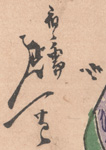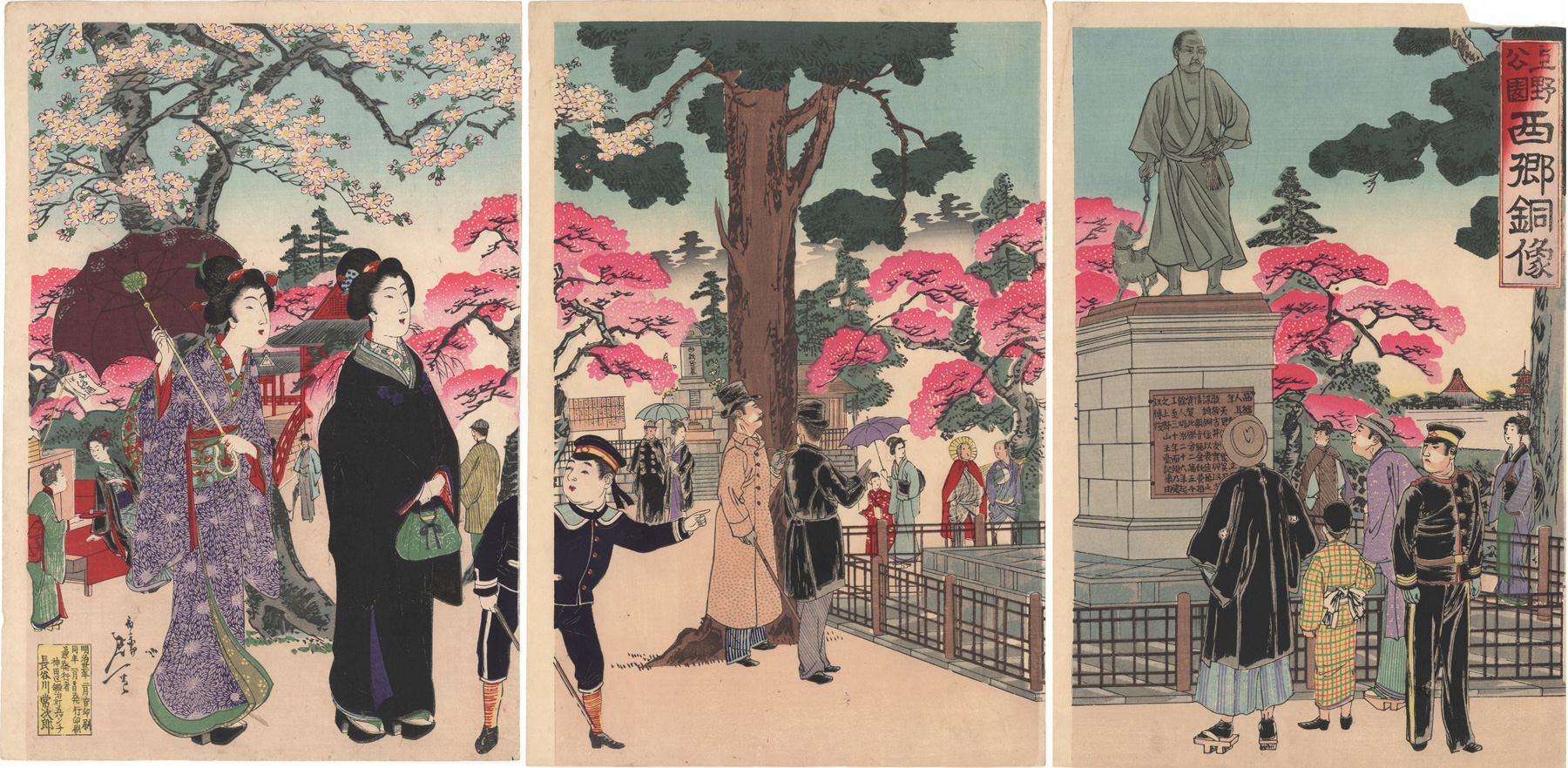About This Print
A spring day in Ueno Park with the cherry trees in bloom and strollers lingering by the recently erected bronze statue of Saigō Takamori, a leader in both the 1867 Meiji Reformation that overthrew the shogun, restoring the Meiji Emperor and bringing a modern government into power, and the 1877 Satsuma Rebellion which sought to overthrow that same government.Among those present when the statue was unveiled on December 18, 1898 were members of Saigō's family, including his widow, Itoko. Her reaction to the statue is described as follows:
Itoko traveled from distant Kagoshima to attend the unveiling ceremony with other members of the Saigo family. She sat next to her late husband’s younger brother, the Marquis Saigo Tsugumichi, who had occupied high posts in the Meiji government, including minister of the navy and minister of the interior. The illustrious gathering waited silently for the veil to be removed. When the statue was finally uncovered, revealing the image, Itoko emitted a sudden shriek. “It looks nothing like my husband,” she exclaimed. She was immediately silenced and later reprimanded by Tsugumichi, out of regard for the “feelings of those many people who went to such trouble and expense to produce the statue.” But Itoko would never overcome here embarrassment at the statue’s informal attire “for all the world to see” – because in life Saigo “was a man of the utmost decorum” who would have worn the formal “hakama and haori bearing the family crest, or a military uniform.”3
1 Splendid Monarchy: Power and Pageantry in Modern Japan, T. Fujitani, University of California Press, 1998, p. 91-92.
2 Samurai Tales: Courage, Fidelity, and Revenge in the Final Yearsof the Shogun, Romulus Hillsborough, Rutland, Vt.: Tuttle Pub., 2010. [Note: On the day of the February 11, 1889 promulgation of the Meiji Constitution, Saigō was exonerated of his role as the leader of disgruntled samurai during the 1877 Satsuma Rebellion and redecorated with the senior third rank for his role in the Meiji Restoration of 1867.]
3 Ibid.
Print Details
| IHL Catalog | #1277 |
| Title or Description | Bronze Statue of Saigō in Ueno Park 上野 公園 西郷銅像 Ueno Kōen Saigōdōzō |
| Artist | Watanabe Nobukazu (1872-1944) |
| Signature |  |
| Seal | none |
| Publication Date | February 6, 1899 明治卅二年 二月 六日 |
| Publisher |  from right to left: 明治卅二年 二月 六日 印刷 [Meiji 32nd year, 2nd month 6th day, printed] 同年 二月 ?日 発行印刷 [same year, 2nd month, [unread] day, published] 兼発行者 publisher and printer 袖田区鍛治町五バンチ Tokyo Kanda Kajichō 5-banchi 長谷常川次郎 Hasegawa Tsunejirō |
| Impression | excellent |
| Colors | excellent |
| Condition | good - full size separate sheets, unbacked, 1 1/2 in. piece of upper right margin on right sheet missing; minor toning and soiling |
| Genre | ukiyo-e; kaika-e |
| Miscellaneous | |
| Format | vertical oban triptych |
| H x W Paper | 14 1/2 x 9 3/4 in. (36.8 x 24.8 cm) each sheet (approx.) |
| Literature | |
| Collections This Print | The Metropolitan Museum of Art JP3350; The New York Public Libary The Miriam and Ira D. Wallach Division of Art, Prints andPhotographs 101539.a-c |


